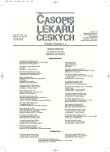-
Medical journals
- Career
Malignant melanoma: standards and innovation in diagnostics and therapy
Authors: P. Arenberger 1; M. Arenbergerová 1; T. Vedral 2
Authors‘ workplace: Univerzita Karlova v Praze, 3. lékařská fakulta, Dermatovenerologická klinika FNKV 1; Univerzita Karlova v Praze, 3. lékařská fakulta, Chirurgická klinika FNKV 2
Published in: Čas. Lék. čes. 2009; 148: 151-157
Category: Review Article
Overview
Cutaneous malignant melanoma originates from neoplastic proliferation of melanocytes. Due to its early lymphogenic and haematogenic metastazing, melanoma belongs to the most malignant tumours. The disease occurs quite early; one quarter of patients with melanoma is younger than 40 years and the mean age of a melanoma patient is 54 years. The incidence of this tumour is growing constantly, about 4% per year. In the central Europe the current incidence is approximately 14 cases per 100.000 inhabitants per year, in the USA it represents 10 to 25 cases and the highest incidence of 50–60 new cases is reported from Australia.
The patient’s prognosis depends on the tumour thickness and the early diagnostics is therefore essential for the favourable disease outcome. The accuracy of the melanoma clinical diagnostics has been enhanced by introduction of dermoscopy, particularly by its digital form. For the trained dermatologist it improves the accuracy of the clinical decision from usual 70 to more than 95%. The malignant melanoma mortality rate remains constant since the eighties of the 20th century. Exploration of new substances which should be able to prolong the patient’s survival in metastatic stage is therefore in progress.Key words:
malignant melanoma, incidence, dermoscopy, circulating cells, sentinel lymph node, immunotherapy, chemotherapy, follow up.
Sources
1. Garbe C. Mangement des Melanoms. Heidelberg: Springer 2006; 4.
2. Ettler K. Fotoprotekce kůže. Praha: Triton 2004; 47.
3. King M, Spooner D, Rowlands DC. Spontaneous regression of metastatic malignant melanoma of the parotid gland and neck lymph nodes: a case report and a review of the literature. Clin Oncol (R Coll Radiol) 2001; 13 : 466–469.
4. Weatherhead SC, Haniffa M, Lawrence CM. Melanomas arising from naevi and de novo melanomas-does origin matter? Br J Dermatol 2007; 156, s.72–76.
5. Balch CM, Buzaid AC, Soong SJ, et al. New TNM melanoma staging system: linking biology and natural history to clinical outcomes. Semin Surg Oncol 2003; 21 : 43–52.
6. Garbe C, Liter U. Melanoma epidemiology and trends. Clin Dermatol 2009; 27 : 3–9.
7. Kittler H. Use of digital dermoscopy to monitor melanocytic lesions: risks and benefits. J Drugs Dermatol 2003; 2 : 309–311.
8. Friedman RJ, Rigel DS. The clinical features of malignant melanoma. Dermatol Clin 1985; 3 : 271–283.
9. Arenberger P, Arenbergerova M, Gkalpakiotis S, et al. Multimarker real-time reverse transcription-PCR for quantitative detection of melanoma-associated antigens: a novel possible staging method. J Eur Acad Dermatol Venereol 2008; 22 : 56–64.
10. Lederman JS, Sober AJ. Does biopsy type influence survival in clinical stage I cutaneous melanoma? J Am Acad Dermatol 1985; 13 : 983–987.
11. Ross MI, Gershenwald JE. How should we view the results of the Multicenter Selective Lymphadenectomy Trial-1 (MSLT-1)? Ann Surg Oncol 2008; 15 : 670–673.
12. Grob JJ, Dreno B, de la SalmoniŹre P, et al. Randomised trial of interferon alpha–2a as adjuvant therapy in resected primary melanoma thicker than 1.5 mm without clinically detectable node metastases. French Cooperative Group on Melanoma. Lancet 1998; 351 : 1905–1910.
13. Kirkwood JM, Ibrahim JG, Sondak VK, et al. High - and low-dose interferon alfa-2b in high-risk melanoma: first analysis of intergroup trial E1690. J Clin Oncol 2000; 18 : 2444–2458.
14. Eggermont AM, Suciu S, Saštinami M, et al. Adjuvant therapy with pegylated interferon alfa-2b versus observation alone in resected stage III melanoma: final results of EORTC 18991, a randomised phase III trial. Lancet 2008; 372 : 117–126.
15. Bedikian AY, Millward M, Pehamberger H, et al. Bcl-2 antisense (oblimersen sodium) plus dacarbazine in patients with advanced melanoma: the Oblimersen Melanoma Study Group. J Clin Oncol 2006; 24 : 4738–4745.
16. Poust J. Targeting metastatic melanoma. Am J Health Syst Pharm 2008; 65 : 9–15.
Labels
Addictology Allergology and clinical immunology Angiology Audiology Clinical biochemistry Dermatology & STDs Paediatric gastroenterology Paediatric surgery Paediatric cardiology Paediatric neurology Paediatric ENT Paediatric psychiatry Paediatric rheumatology Diabetology Pharmacy Vascular surgery Pain management Dental Hygienist
Article was published inJournal of Czech Physicians

-
All articles in this issue
- Malignant melanoma: standards and innovation in diagnostics and therapy
- Formation of the vascular bed: a review of its molecular mechanisms and therapeutic implications
- Mirizzi syndrome with cholecystoduodenal fistula – a rare complication of cholecyctolithiasis
- Bloodless medicine
- Treatment of marijuana dependence
- The first Obesity Unit in Czechoslovakia was established twenty years ago
- The safety profile of anti-tumour necrosis factor therapy in inflammatory bowel disease in clinical practice: analysis of 620 patient-years follow-up
- Immune response to influenza vaccine in children with inflammatory bowel disease
- Cyclosporine and infliximab as rescue therapy for each other in patients with steroid-refractory ulcerative colitis
- Journal of Czech Physicians
- Journal archive
- Current issue
- Online only
- About the journal
Most read in this issue- Mirizzi syndrome with cholecystoduodenal fistula – a rare complication of cholecyctolithiasis
- Bloodless medicine
- Malignant melanoma: standards and innovation in diagnostics and therapy
- Treatment of marijuana dependence
Login#ADS_BOTTOM_SCRIPTS#Forgotten passwordEnter the email address that you registered with. We will send you instructions on how to set a new password.
- Career

